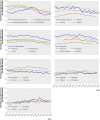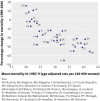Disparities in breast cancer mortality trends between 30 European countries: retrospective trend analysis of WHO mortality database
- PMID: 20702548
- PMCID: PMC2920378
- DOI: 10.1136/bmj.c3620
Disparities in breast cancer mortality trends between 30 European countries: retrospective trend analysis of WHO mortality database
Erratum in
- BMJ. 2010;341:c4480. LaVecchia, Carlo [corrected to La Vecchia, Carlo].
Abstract
Objective: To examine changes in temporal trends in breast cancer mortality in women living in 30 European countries.
Design: Retrospective trend analysis. Data source WHO mortality database on causes of deaths Subjects reviewed Female deaths from breast cancer from 1989 to 2006
Main outcome measures: Changes in breast cancer mortality for all women and by age group (<50, 50-69, and >or=70 years) calculated from linear regressions of log transformed, age adjusted death rates. Joinpoint analysis was used to identify the year when trends in all age mortality began to change.
Results: From 1989 to 2006, there was a median reduction in breast cancer mortality of 19%, ranging from a 45% reduction in Iceland to a 17% increase in Romania. Breast cancer mortality decreased by >or=20% in 15 countries, and the reduction tended to be greater in countries with higher mortality in 1987-9. England and Wales, Northern Ireland, and Scotland had the second, third, and fourth largest decreases of 35%, 29%, and 30%, respectively. In France, Finland, and Sweden, mortality decreased by 11%, 12%, and 16%, respectively. In central European countries mortality did not decline or even increased during the period. Downward mortality trends usually started between 1988 and 1996, and the persistent reduction from 1999 to 2006 indicates that these trends may continue. The median changes in the age groups were -37% (range -76% to -14%) in women aged <50, -21% (-40% to 14%) in 50-69 year olds, and -2% (-42% to 80%) in >or=70 year olds.
Conclusions: Changes in breast cancer mortality after 1988 varied widely between European countries, and the UK is among the countries with the largest reductions. Women aged <50 years showed the greatest reductions in mortality, also in countries where screening at that age is uncommon. The increasing mortality in some central European countries reflects avoidable mortality.
Conflict of interest statement
Competing interests: All authors have completed the Unified Competing Interest form and declare no financial or non-financial interests that may be relevant to the submitted work.
Figures


Comment in
-
UK cancer survival statistics.BMJ. 2010 Aug 11;341:c4112. doi: 10.1136/bmj.c4112. BMJ. 2010. PMID: 20702551 No abstract available.
-
[Differences in breast cancer mortality in 30 European countries over 17 years].Praxis (Bern 1994). 2010 Dec 1;99(24):1514-5. doi: 10.1024/1661-8157/a000326. Praxis (Bern 1994). 2010. PMID: 21125538 German. No abstract available.
-
Beware using secular trends in deaths to judge effectiveness of breast screening.BMJ. 2013 Jul 10;347:f4335. doi: 10.1136/bmj.f4335. BMJ. 2013. PMID: 23842431 No abstract available.
Similar articles
-
Breast cancer mortality in neighbouring European countries with different levels of screening but similar access to treatment: trend analysis of WHO mortality database.BMJ. 2011 Jul 28;343:d4411. doi: 10.1136/bmj.d4411. BMJ. 2011. PMID: 21798968 Free PMC article.
-
Breast cancer incidence and mortality trends in 16 European countries.Eur J Cancer. 2003 Aug;39(12):1718-29. doi: 10.1016/s0959-8049(03)00118-7. Eur J Cancer. 2003. PMID: 12888367
-
European trends in breast cancer mortality, 1980-2017 and predictions to 2025.Eur J Cancer. 2021 Jul;152:4-17. doi: 10.1016/j.ejca.2021.04.026. Epub 2021 May 29. Eur J Cancer. 2021. PMID: 34062485
-
Ovarian and endometrial cancers.Cancer Surv. 1994;19-20:287-307. Cancer Surv. 1994. PMID: 7895220 Review.
-
Changes in diet and mortality from selected cancers in southern Mediterranean countries, 1960-1989.Eur J Clin Nutr. 1993 Sep;47 Suppl 1:S25-34. Eur J Clin Nutr. 1993. PMID: 8269895 Review.
Cited by
-
Big data in breast cancer: Towards precision treatment.Digit Health. 2024 Nov 3;10:20552076241293695. doi: 10.1177/20552076241293695. eCollection 2024 Jan-Dec. Digit Health. 2024. PMID: 39502482 Free PMC article. Review.
-
Dancing With Health: Quality of Life and Physical Improvements From an EU Collaborative Dance Programme With Women Following Breast Cancer Treatment.Front Psychol. 2021 Feb 24;12:635578. doi: 10.3389/fpsyg.2021.635578. eCollection 2021. Front Psychol. 2021. PMID: 33716903 Free PMC article.
-
Is the tide turning against breast screening?Breast Cancer Res. 2012 Jul 13;14(4):107. doi: 10.1186/bcr3212. Breast Cancer Res. 2012. PMID: 22805502 Free PMC article.
-
miR-136 suppresses tumor invasion and metastasis by targeting RASAL2 in triple-negative breast cancer.Oncol Rep. 2016 Jul;36(1):65-71. doi: 10.3892/or.2016.4767. Epub 2016 Apr 25. Oncol Rep. 2016. PMID: 27108696 Free PMC article.
-
Trends in incidence, mortality and survival in women with breast cancer from 1985 to 2012 in Granada, Spain: a population-based study.BMC Cancer. 2018 Aug 2;18(1):781. doi: 10.1186/s12885-018-4682-1. BMC Cancer. 2018. PMID: 30068302 Free PMC article.
References
-
- Levi F, Bosetti C, Lucchini F, Negri E, La Vecchia C. Monitoring the decrease in breast cancer mortality in Europe. Eur J Cancer Prev 2005;14:497-502. - PubMed
-
- European Commission. Cancer screening in the European Union. Report on the implementation of the council recommendation on cancer screening. First report. 2008. http://ec.europa.eu/health/ph_determinants/genetics/documents/cancer_scr....
-
- Coebergh JW, Albreth T. Should the EU also wage war against cancer? And if so, how? Eur J Cancer 2008;44:1341-4. - PubMed
-
- Micheli A, Coebergh JW, Mugno E, Massimiliani E, Sant M, Oberaigner W, et al. European health systems and cancer care. Ann Oncol 2003;14 (suppl 5):v41-60. - PubMed
Publication types
MeSH terms
LinkOut - more resources
Full Text Sources
Other Literature Sources
Medical
